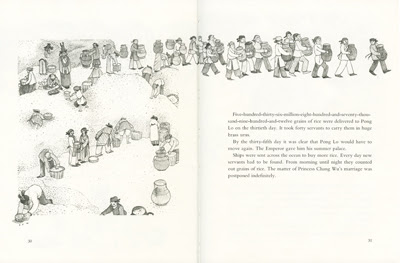 |
| CLICK ON THE IMAGE TO VISIT COLLABORATION CUTIES MUST READ MENTOR TEXTS. |
The book is a simple variation on the old grains on a chessboard example of exponential growth. As a reward for concocting a potion which saved the life of the princess, humble farmer Pong Lo asks for the Emperor's daughter's hand in marriage. The Emperor is willing to offer Pong Lo anything he wishes, except for the hand of his daughter, the princess.
Pong Lo then surprises the Emperor by making a basic request. He asks for a single grain of rice doubled every day for 100 days. The Emperor is baffled, yet he complies. He soon discovers that Pong Lo uses his math skills and ingenuity to make all his wishes come true.
From Helena Clare Pittman's website:
"The peasant, Pong Lo, falls in love with the princess, Chang Wu, presenting, of course, the problem of class, for starters. But this peasant is "more than a little" clever, gifted and determined. With the conviction of love in his heart he defies tradition and common sense, becoming indispensable to the workings of the emperor's palace, and dear to emperor's love of good food and to his daughter's heart. The story unfolds from there and rests on Pong Lo's wit, and knowledge of arithmetic progression. This book has been in print since 1986, used in school curriculums since 1994, and is a love story on a royal scale."
This story is a great introductory lesson to the patterning and algebra strand in the Ontario Curriculum for mathematics. I also like to use it prior to this lesson I wrote about INTERACTIVE MATH NOTEBOOKS. The mathematical focus for this lesson the exponential growth of the powers of 2.
Prior to reading the story, I ask the students to consider this question: "Would you rather have $0.10 each day for 10 days or would you rather receive a penny on the first day and double that amount everyday for 10 days? I allow students to think about the question but not give me any responses at this point.
I then begin to read the story and stop on the page where Pong Lo asks for a grain of rice which will double every day for one hundred days.
I then revisit the question I posed about the money. With a partner I ask the students to determine how much money they would receive, depending on which decision they made. We debrief the strategies used, and the answers the students come up with. I like to use this as a bit of a diagnostic assessment of strategies students use.
I then ask the students to determine how much rice Pong-Lo would have at the end of 100 days. Again they work with their partners. I like to use the KWC (Know, Want to Know and Conditions) model to have students work on the problem in partners. I have them go through each step included in the table you see below.
K: What do I KNOW? Based on the problem, I know that...
W: What do I WANT to do, find, or figure out? I am trying to find or figure out...
C: CONDITIONS. Are there are special conditions? (e.g. that Pong Lo requests a single of grain rice which doubles each day for 100 days)
There is no right or wrong way for the students to use the table, but they must fill out all sections. I find that gifted students often are able to come up with the correct answer but they cannot show how they know they are correct, and they have trouble explaining their thinking and/or making connections. Using APEC gets my students thinking about the entire problem solving process and how the concepts they have been learning about connect to other math concepts, to themselves and to the world around them.
 |
| CLICK ON THE IMAGE ABOVE TO DOWNLOAD YOUR OWN FREE COPY. |
Prior to finishing the story but after the students are finished working on the problem they share their thinking, discuss the process and the answer.
I then finish reading the story to the students and we talk about what that much rice would look like. How would Pong Lo store it all? What could he store it in? Exploring a variety of measurement concepts are a natural extension to these questions.
I then finish reading the story to the students and we talk about what that much rice would look like. How would Pong Lo store it all? What could he store it in? Exploring a variety of measurement concepts are a natural extension to these questions.
Another extension I have used with my students is to have them create their own story related to the concept, powers of 2. This can be used as an excellent cross curricular connection to language arts, visual arts and technology.
Head over to Collaboration Cuties now to read about more great Must Have Mentor texts!












This looks great! I've read a book similar to this called Obe Grain of Roce I think. I love that you question them before you read the story! I love those organizers! I need to check those out for sure!!
ReplyDeleteThanks for linking up!
Amanda
Collaboration Cuties
There are several books which are similar Amanda. One Grain of Rice is another book, it's by Demi and the setting is in India. You can use either text to teach the concept. I like the book I chose to post about because it is culturally appropriate for the population of my class and my school. I like to use culturally diverse books though, and perhaps I will add the other text to my collection too!
ReplyDeleteSidney
Wow! You've done an awesome job of taking a regular classroom routine idea (like the KWL chart) and really shown how we can extend it to challenge our students. Thank you for sharing!
ReplyDeleteWhy thank you Veronica. I like to think that sometimes the KISS (Keep it Simple Sweety) theory works best! I find that if I use something the students are familiar with, such as KWL and switch it up a bit...like KWC and then add to it...APE...(I added the C later) I can "hook" into their prior learning and experiences. I use APEC in both math and language with a pretty high level of success. I can't say it works for all of my students, but for those who need a "format" to help them, I have seen gains in achievement.
ReplyDeleteSidney
This is a book that I have seen many times and always pass over - I guess I really should check it out!
ReplyDeleteI was told this story as a child and I still remember it! Love that I could now use it in my teaching!
ReplyDeleteButterflying Through Teaching